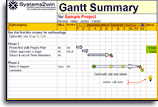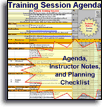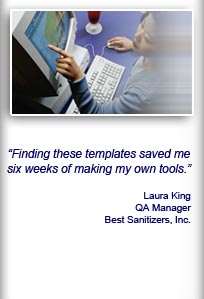Installation and Setup
Installation - Each User. Installation - Multi-user. Language Translations. Personalize Your Templates.Systems2win Training.
Quick Start Initial Training. New User Training. Training Matrix. Systems2win Leadership. Training Classes.Lean Training
Lean Training and Coaching. Lean Principles. Muda 8 Wastes. Goal - Lean Flow. Roadmap - Lean Journey. Value Stream Mapping. Standard Work. Hansei Lean Thinking. Lean Dictionary. Online Lean Training. Lean Leadership.Microsoft Office Training
Excel Training. Excel Drawings (without Visio). Excel Charts. Word Training. PDF Training. Document Storage and Naming.Support
Support.Lean Management
Tools and Systems
Lean management tools, lean daily management system, lean coaching, and more
Lean Management System
Every element of every lean production system should be simultaneously implemented with a corresponding lean management system to support and sustain it
Essential elements
of a lean management system
Lean Leadership
If you don't have lean leadership,
it is very difficult for an isolated team to implement any kind of effective lean management system for very long.
How to start your Lean Journey
for different leadership environments

Leader Standard Work
In addition to requiring written audited Standard Work for every process that they manage,
every Team Leader, Supervisor, Value Stream Manager, and (yes, even) top-level executive checks off their own Leader Standard Work checklist as they perform their own routine managerial responsibilities
as a field-proven systematic way to get above-average results from average managers.
Visual Controls
are the most obvious indicator of a lean management system.
Visual management systems stand out, are an essential component of any lean system, and are supposed to be implemented as the very first element of any lean management system.
For every type of Continuous Improvement team — one of the required outcomes must be to establish excellent Visual Management Systems — so that with one quick glance, any first-time visitor can know whether or not every process is (or is not) achieving its objectives.
Routine Accountability Habits
including frequent gemba walks, systematized PDCA Coaching, and multi-tiered daily stand-up meetings, where the visual Team Accountability Board serves as the meeting place, agenda, and progress report.
Every person in your company is the member of at least one, and often several teams.
Every Process Improvement Team is systematically held accountable to demonstrate process improvement effort and results on a routine basis (often daily).
Lean Management Tools
Team Leadership tools
If it is true that "management is the art of getting things done through other people",
then it will be a rare manager indeed who does not need to lead one or more teams.
When you download your free trial, you get...
- A dozen templates that your teams will use for process improvement
with a 30-day trial period
- A dozen templates that you will use for lean team leadership
with no expiration date
Use your new lean management templates for the rest of your career — free
Our gamble is that once you become familiar with your Systems2win templates that have
- consistent, standardized features, help, and training
- language translations for your global team
- live technical support

you will wonder aloud...
"Why are we paying our expensive lean leaders
to try to invent, re-invent, and support inferior tools?"
Lean Assessment template
to assess the progress of each team's lean journey
- Easy-to-understand-at-a-glance trend charts, thermometer charts, and radar chart
- Easily personalized with your own assessment criteria
- Completed by all levels of leadership on a periodic basis
- 5-minute mental preparation for your weekly gemba walk
One Good Idea — Before & After Storyboard
aka Lean storyboard, Six Sigma story board

Before & After Storyboard
Very motivating, and extremely easy to use:
- Personalize your working document
by selecting your desired section headers and team roles from the dropdown lists
- Edit
inserting pictures, and writing written descriptions
- Publish and Socialize
on your team drive, Team Accountability Board, and other bulletin boards
- Maintain a 3 ring binder of implemented ideas for each team
Leader Standard Work template
for your Team Leaders, Department Supervisors, Value Stream Managers, and Executives
- Standard work is the cornerstone of every lean production system,
and should also be a cornerstone of every lean management system
- Lean leadership checklists should be carried and followed for a large percentage of lean management tasks:
-
Team Leaders — 80% of their time should be devoted to completing leader standard work

Leader Standard Work
template - Department Supervisors — 50%
- Value Stream Managers — 25%
- Executives — 10%
-
(These percentages are lower in a lean healthcare or lean office environment, but the fundamentals of the underlying lean management system are the same)
Strategic Planning and Policy Deployment
Someone needs to climb the tallest tree to see above the forest.
And then it's not enough to just choose a strategic direction and set a few strategic milestones.
You need systematic ways to communicate that vision, inspire others to share and extend that vision, and to actually pull together toward that inspiring future.
Kaizen Event Leadership
Your lean management tools include templates and training to:
- Plan a Kaizen Event
- Lead it, and then...
- Follow up to measure results to ensure that the desired changes stick.
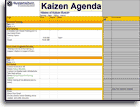


Tools to lead a Kaizen Event
Templates for A3 Lean Management
Some of your team members aren't willing to be locked in a room for a multi-day Kaizen Event?
(Doctors? VP's? Customers? Suppliers?)
No problem. Your Systems2win templates also include an entire suite of templates for A3 Problem Solving and A3 Management.



Templates for A3 Management
Not just the A3 Template that is a free gift when you download your trial, but an entire suite of templates to take your A3 Management to whole new levels.
PDCA Kata Coaching templates
As part of your Improvement Kata routine habits, use your PDCA template for Learner and Coach to maintain a record of past experiments, results, and learnings — and to plan your next PDCA experiment.
Immediately after each coaching session, your Coach's Coach uses the PDCA Coaching Observations template to mentor both you and your Coach to more fully embrace the teachings and habits of both the Improvement Kata and the Coaching Kata.
Publish your printed PDCA Coaching template on your Team Accountability Board to serve as a Lean Storyboard.
Project Management tools
Lean leaders usually prefer one or more of the above (more time effective) ways of managing teams, but there are times when traditional project management tools and methods are still the best choice.
(think Christmas Party, moving to a new facility, implementing new software...)
Your Systems2win templates also include a suite of templates for traditional Project Management.
Team Training tools
A big part of being a lean manager is being a lean trainer.
Your Systems2win Lean Management bundle of templates comes with a Training Session Planning template, a Cross Training Matrix, Excel Self-Paced Learning, and more.
And most Systems2win customers own all 150+ templates, which include many additional lean training templates, training pages, and videos to teach your people what they need to know as they turn each next corner on their lean journey.
Tool Selection Matrix
Not sure which tools to consider as you round yet another corner of yet another twisting lean journey?
Your Tool Selection Matrix allows you to use Excel's powerful Filter features
to systematically narrow down your options
to the few templates that are most likely
to guide you and your team
to use the right tool for what you need next.
Hands-on Lean Management tools
All of the above templates come with the Lean Management bundle of templates.
The scary truth is that all of the above tools and methods don't actually accomplish anything other than to set the stage to make it possible for a team to actually change something.
The best lean leaders don't just 'manage'. They lead.
They lead by example.
They physically go to the gemba (the place where the work is done)
and they themselves demonstrate competence to personally use some of the same lean tools and methods that they want their people to use.
Some of the more popular 'hands-on' lean management tools used by lean managers include:
- Value stream mapping
The primary bridge between lean management and hand-on process improvement
- 5S Audits
Because the only way that problems can be fixed is if they are first revealed
- Lean six sigma tools
Ideally to prevent fires, but sometimes because a fire needs to be fought
- Standard work audits
To ratchet gains — and prevent backsliding into old habits
- Online training and consistent templates to shape the habits of your lean leaders to systematically achieve that popular but slippery goal — to institute a lean culture



What drives cultural change?
Expectations for clearly defined behavior, and consistently applied processes for supporting it.
Every element of any lean production system
must have a corresponding lean management system element to support it.
"If I had to choose between lean training for a new recruit to lead a lean area or providing him or her with a copy of clearly written standard work, I would choose standard work every time."
David Mann ~ Author of Creating a Lean Culture
Lean Management Systems for
Routine Accountability Habits
Lean Management systems to instill Lean Culture habits
- Leader Standard Work
- Assessment Audits
- Stand Up Meetings
- Visual Controls
- Gemba Walking
- Kata — Habits for Lean Coaching
Leader Standard Work
A Routine Accountability Habit for Lean Management

Leader Standard Work checklists are carried and followed by every Team Leader, Department Supervisor, Value Stream Manager, and top-level executive
as a way to systematically get above-average results from average people.
A Routine Accountability Habit for Lean Management

Each leader's standard work should include periodic audits — using audit checklists to remind them of what to always look for, and to provide a written archive record that can be analyzed for trends.
Audit checklists can be created for anything
that significantly influences the effectiveness of any process.Popular audit checklists include the Standard Work Audit, the Lean Assessment Audit,
and the 5S Scorecard.
How do you get diverse people to assess audit questions using consistent criteria?
- The most senior leader reviews audit criteria with subordinate leaders — getting verbal agreement.
- Do an audit together — with each leader completing their own separate form — then compare and discuss.
- For the next few audit cycles (perhaps weekly) — have each leader complete an independent audit of the same area — and then get together to compare and discuss.
- Repeat — until audit assessments are reasonably in sync between all leaders.

Are you ready for your next audit?
Stand Up Meeting
A Routine Accountability Habit for Lean Management
Your Systems2win Leader Standard Work template includes detailed suggestions for how to structure
4 tiers of routinely-scheduled stand up meetings
- Team Leader
with production team members - Department Supervisor
with Team Leaders - Value Stream Manager
with Supervisors and support resources - Executive or Senior Manager
with Supervisors and Value Stream Managers
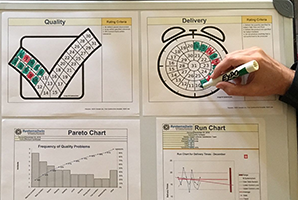
Use your SQDC template
for highly visual, motivating headers for each column of each Team Accountability Board
Each stand up meeting is usually held in front of each team's Team Accountability Board
Visual Controls
Your Team Accountability Board is the epicenter of visual controls for each team.
There are many more types of visual controls that are very helpful for different common situations and environments, including:
- Acid Test for Lean Flow
- Jidoka signals to stop work before any more defects are released
- Visual Management Systems for Lean Office and Lean Service environments
Learn more about the many types of visual controls.
The next routine lean management accountability habit will be made a whole lot easier and more productive when you have effective Visual Controls — Gemba Walking.
Gemba Walk for Lean Management
Go to the place, look at the process, talk with the people
The primary purpose of gemba walking is to teach
Yes, there are many other benefits:
- You (the gemba walker) also learn.
"The best way to learn is to teach"
- You observe, monitor, and audit the process, and its visual management systems
- Gemba walks spurt a fountain of new ideas for continuous improvement
But the overwhelming primary purpose of a gemba walk is to teach.
The role of the lean sensei
When you are the gemba walker, you are playing the role of sensei (mentor, coach, teacher).

A gemba walk is a master-disciple, teacher-student form of learning
where your goal as sensei is to ask coaching questions
(fighting your strong impulse to just tell them what to do)
Questions that cause your student to see things differently, to look at a process that may be many years familiar to them, and to see it fresh and anew with 'kaizen eyes', suddenly seeing waste that has always been there, but that suddenly becomes visible in an 'aha' moment.
'Aha' moments happen only when a student is actively thinking, not just receiving information.
And the best way to trigger lean thinking is to ask questions.
Questions designed to cause the learner to see waste that they never noticed before
and questions designed to stimulate the learner to creatively apply lean tools, methods, and teachings in creative, improvised ways that fit the needs of this unique situation.
Every lean implementation is an invention
Each unique situation almost always requires some invention and adaptation of lean principles.
In the real world, it is rare to be able to apply a tool or method in the exact same form that it was introduced in a book, or even in a Systems2win template. That's one reason that your Systems2win templates are written using Microsoft Word and Excel — so that it's easy to personalize them for your unique situations that you encounter on your lean journey.
The role of the sensei is to ask questions, introduce new tools and approaches, stimulate new thinking, teach, and (sparingly) to give advice...
The learner should always be responsible for making all decisions. The only decision that the sensei makes is whether to continue working with the learner — based on their follow through to commitments.
The payoff of the Socratic method
The primary benefit of this Socratic method of asking questions (instead of just telling answers) is that the student learns much more thoroughly.
Thoroughly enough to soon start doing their own gemba walks with their own subordinates, with your student slowly but surely evolving into their own incarnation of master sensei.
The problem with gemba walk lean management
The primary challenge of this gemba walk method of learning is that it is slow. It requires patience.
To be most effective, gemba walking should start from the top down. Gemba walking should ideally start with a very experienced consultant serving as the sensei for your President and executive-level Change Agent. Just seeing your top-level leaders out there on the production floor on a weekly basis will do wonders to deliver the message to everyone in the company that "this change initiative is different".
Let the boss be the boss... (sensei)
By nature, senior-level managers and executives are far more comfortable in the role of leader, rather than learner.
So rather than putting them in the position of being a "student" right there in front of the people they manage,
it a much better idea for the consultant sensei to serve as a tactful mentor
helping each executive prepare for 15 minutes before each of his or her gemba walks, and then spending time after each gemba walk to help the executive learn from the fresh experience and use what was just learned to prepare for the next one
and yet allow the executive to play the role of sensei even on their first gemba walks, with the consultant only intervening with tactful guiding questions if and when the executive truly seems to need help.
Use your Lean Assessment template for gemba walk preparation

Yes, consulting time can get expensive,
and yes, most executives are quick learners that will be very motivated to do some self-study so that they can quickly be as competent and comfortable as possible with this new highly visible role.
That's where the Systems2win Lean Assessment template is so valuable...
A quick 5-minute review of these lean performance evaluation criteria will quickly refresh the executive's mind with the things to look for and questions to ask on their upcoming gemba walk.
The purpose of a gemba walk is to observe what is actually happening at the place where the work is being done, and to mentor by asking questions and perhaps introducing or reminding of potentially helpful lean tools and teachings.
Rather than entering data into the form after each gemba walk, and rather than bringing a printed copy of this Assessment on gemba walks, we suggest instead to simply... spend a few minutes reviewing this Assessment form prior to each gemba walk as an excellent way to prepare yourself mentally.
Coaching Kata / Improvement Kata
What are some field-tested guidelines for how to coach people?
What questions should I ask when I'm the Lean Leader on my gemba walks, or my audit discussions, or the Leader Standard Work review meetings with my subordinates, or as part of a regularly-scheduled stand up meeting?
How does a lean coach think? And teach his people to think the same way?
That is the subject of the Coaching Kata habits, taught in Chapter 8: The Coaching Kata: Leaders as Teachers, of Mike Rother's book, Toyota Kata, and his website expands the instruction even further in the Toyota Kata Handbook.
Mike's book, however, focuses on how to serve as a Coach for one specific technique — the Improvement Kata.
The Improvement Kata is appropriately used when one specific condition is encountered:
Navigating Unknown Territory
If you are navigating unknown territory,
then use your PDCA Coaching template.
If you are not navigating unknown territory,
then you should be using your Tool Selection Matrix to find a more appropriate approach for the challenge you are facing at the moment.
Also see more suggested readings for Lean Management
Don't be a one-trick pony
We have observed some executives that have learned only one lean management system, (such as the Coaching Kata), and then attempt to use that one technique for every challenge.
In our opinion, those leaders will be more effective when they expand their repertoire.

Truth in humor
See our short article on
Getting Team Members to Do What You Want
- The cat training school of thought
- The dog training school of thought
- The horse training school of thought
Lean Coaching habits
for ANY Lean Management System
Every lean tool and lean system needs a coaching system.
Here are some lean coaching habits that should become so ingrained
that they are "just the way we do things around here".
Coach your people to communicate suggestions and ideas
The document Author is the only one authorized and responsible to edit the document.
Everyone else suggests ideas that are then accepted, rejected, or revised by the Author.
See online training for how to communicate with the document Author.
Do 2 things at once
As a Coach, your goals are:
- to get things done
- to teach your people to use lean thinking in everything they do
Observe
Go to the place where the work is done — and observe what is happening for yourself.
Go there repeatedly. Most coaching should be done where the work is done.
Ask non-leading questions
The best questions might have more than one obvious answer — and cause your people to honestly think and reflect, and maybe come up with ideas that you might have never considered.
Return again and again to the Hansei questions to stimulate Lean Thinking.
Ask leading questions
Don't let your Learner wander too far away from the general direction of the target challenge.
Be systematic
Expand your own personal competence with a wide variety of process improvement tools and methods, so that you can suggest helpful field-proven systematic approaches to any challenge.
Be creative
If there is no well-known standard lean system that exactly fits what you're trying to accomplish, then use your Tool Selection Matrix to start with the closest one, then personalize it — using what you know about Lean Principles and your team's imagination to apply those principles in new, creative ways.
Have a 2nd Coach
Every sensei needs a sensei.
Every lean coaching system should include a systematic way to coach the coach.

"The primary role of managers must shift from fire fighting
to designing, aligning, and improving systems."
~ Dr. Shigeo Shingo
Follow these links to more...
Lean Management
Training & Videos
- How to Launch a Process Improvement Team
- How to Listen to the Voice of the Customer
- How to Measure Results
- Lean Leadership
- Leader Standard Work
- Visual Controls for lean visual management
- The Role of the Change Agent
- Hoshin Planning Strategic Policy Deployment
- Problem Solving Tools & Methods
- Root Cause Analysis Tools
- A3 Problem Solving
- Brainstorming
- Kaizen Event leadership
- Standard Work for production operations
- Kaizen and Lean Training home page
- Lean Transformation lean journey
- Lean Training home page
Suggested Reading and Resources for
Lean Management Systems
- Creating a Lean Culture, by David Mann
- Toyota Kata, by Mike Rother
- Balanced Scorecard, by Robert Kaplan and David Norton
- Lean Thinking, by James Womack and Daniel Jones

Contents

No, we're not going to
buy you any tools...
but we don't want any excuses when those deadlines are due
Own Yours Now
Own your own professional tools
that you can take with you for the rest of your career
Training and Coaching
Consider Training and Coaching to support your teams to succeed

Training to get you started.
Tools you won't outgrow.
Schedule a Conference
Schedule a conference
to discuss your challenges
with an experienced lean advisor
Download Trial Now
Get a dozen trial templates,
and another dozen free gifts
@@@ Better conversion rate
if call to action is for a specific tool, and shows the image

Try It
Try this template
along with a couple dozen more
process improvement tools
Calls to Action Botttom
Related Topics
Related Topics section WITHOUT TESTIMONIALS
Replace this paragraph with menu library item for topics related to this video
Training and Coaching
Consider Training and Coaching to support your teams to succeed

Training to get you started.
Tools you won't outgrow.
Schedule a Conference
Schedule a conference
to discuss your challenges
with an experienced lean advisor








